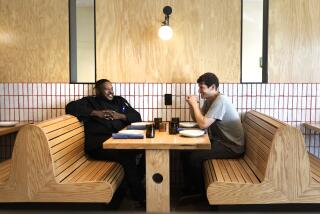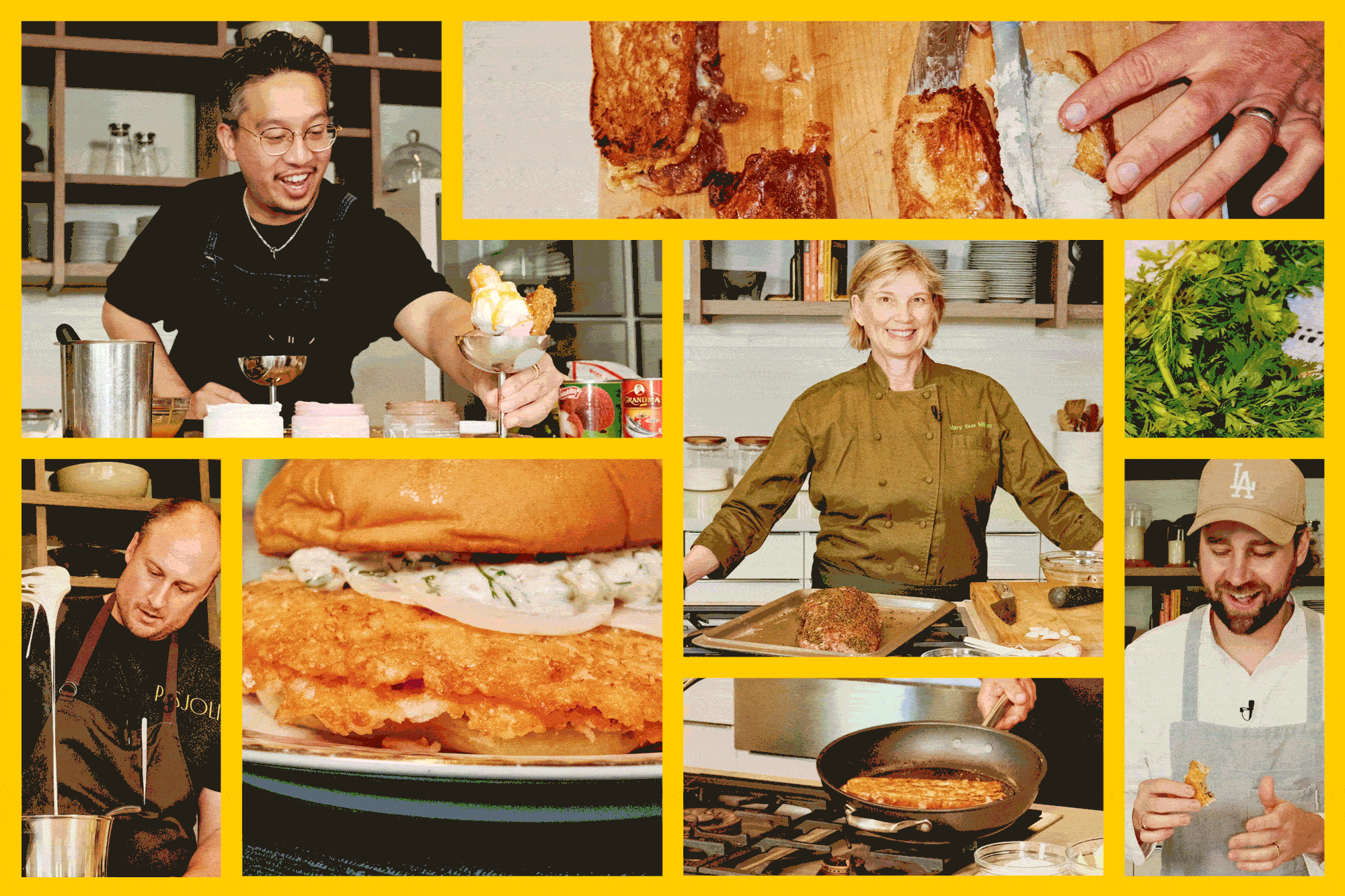Cooking Up Careers : Chefs’ Training Is on the Front Burner in ABC District
Theresa Brooks, 29, has been a registered nurse for more than four years but isn’t “real crazy about it.”
Terrence Collins, 43, injured his neck and no longer works as a pipe fitter and welder.
Brenda Gilliam, 26, who has four children, wants to open a pastry shop with her husband, who soon will be discharged from the Army.
Marc Allen, 22, has always wanted to be a chef.
Brooks, Collins, Gilliam and Allen have at least two things in common: They love to cook and are paying $30 for a six-month course to learn to do it professionally.
The course, at the ABC Unified School District’s Culinary Arts Center in Cerritos, teaches the fine points of preparing food, as well as restaurant management and operation.
Basic Training
“There is no other program like it. Others have training programs but they are not as complete,” said Virgil L. Hall, assistant superintendent-business for the ABC district.
Students attending the center, on the campus of Whitney High School, begin with basic training--dish-washing--and progress to baking and preparing gourmet dishes. Everything from soup to nuts, as the saying goes.
Each weekday at 6 a.m., 20 to 25 students put on their eight-inch-tall white hats and white jackets and start preparing, chopping, carving, trimming, cutting, boiling, baking and cooking meals that later in the day are served to paying customers.
When students complete the course, they will know how much soap goes in dishwater, how to fold a napkin, the proper way to set a table, and the correct method of serving--beverage from the right side and food from the left. And they will be able to cook a gourmet meal.
“You learn a lot and the price is right,” said Allen, who is from Buena Park and has been cooking since he was a teen-ager.
Allen always had wanted to go to chef school but “it is too expensive. To go to the California Culinary Academy in San Francisco would have cost me more than $10,000,” he said.
Hundreds Placed
District officials estimate that in a five-year period the program has found jobs for several hundred students in large and small restaurants. They have been placed as waitresses, waiters, fry cooks, short-order cooks, food service assistants, hostesses and chef apprentices.
The food prepared by the student cooks is served in the school’s restaurant, which is open to the public for breakfast and lunch. The restaurant, which has more than 30 tables, is popular with district employees; the prices are lower than at comparable restaurants. On the average, breakfast is about $1.95 and lunch entrees about $3.25; all pastries are 85 cents.
“Our prices are not competitive. We are not running a business to make a profit,” Hall said.
And the food, he said, “is excellent. I eat there every day.”
A typical lunch menu recently included clam chowder, stir-fry pork with cucumber, turkey Marco Polo sauce gratin, filet of sole saute casino, stuffed potatoes, broccoli and cauliflower with orange parsley sauce, medley squash Provencale and vegetables bouquetiere.
Chocolate cake, several different types of cheesecake and a carrot cake were on the dessert tray.
A fast-food stand and sandwich shop adjoin the restaurant for students attending Whitney, a public high school for college-bound students.
The mastermind in the culinary arts kitchen is Marvin Slaughter, 50, who in 1977 was voted chef of the year by the Chef de Cuisine Assn. of California while he was executive chef for the Ambassador hotel in Los Angeles.
“This is a great job,” said Slaughter, who earns about $37,000 a year for running the school. “I love the hours. I love having weekends off and getting regular vacations, something unheard of working as a chef for a large restaurant.
“But most of all, I love working with the students and preparing them for entry-level jobs into the food service industry.
Seeks Mature People
“Not all of these students will be chefs. But we try and give them an understanding of the industry,” said Slaughter, who has three assistants. “We want mature people who are ambitious, hard-working and willing to learn.”
Slaughter, who has nine children and 14 grandchildren, was trained in cooking at Los Angeles Trade Technical College and ran his own restaurant in San Pedro for about four years. He also has worked as a chef for a variety of food chains, large hotels and restaurants.
The center accepts high school seniors from the district as well as adults. Adult students come from a variety of professions, said Slaughter, some of them paralleling his path to the chef’s hat.
Slaughter, who worked in a machine shop after being discharged from the Navy in 1955, changed careers after losing part of his left hand in a milling machine accident in 1956.
“I decided to do something that was safer than working with machines,” said Slaughter. “We have had construction workers, type-setters, salesmen and a male model.”
Brooks is one of the students who is not interested in becoming a chef but would like to start a catering business someday.
After her 4 1/2 years as a nurse, Brooks, who lives in Whittier, says she is interested in changing careers.
“I like to cook. I feel like I can express myself artistically through cooking,” she said.
Gilliam said she also satisfies creative impulses through cooking; her canvases are pastries. The center also will train her to manage the pastry business she hopes to start with her husband, who is retiring from the Army.
She likes designing cakes, especially cheesecakes.
“You can do so much with them. You can fill them with raspberry one day. The next day you can use peaches,” Gilliam said.
Collins, who is from Irvine, said that after sustaining a disabling injury while working as a pipe fitter and welder, he began searching for “some other career to pursue. This is a whole lot different, going from what I was doing to chopping onions, frying hamburgers and cutting lettuce.”
In addition to learning to cook, one night a week the students receive classroom instruction.
European-Style Cooking
“I try to teach them basic knowledge about cooking in the European style because that’s what the good restaurants are looking for,” said Slaughter, who wears the tallest white hat--his is 12 inches.
“I teach them how to decorate the food. Food has got to look pretty,” he said.
The center does not guarantee a job, but it tries to help the trainees in seeking employment, said Norman Roberts, director of the district’s food services.
“With Marvin’s contacts, district brochures that advertise the program and the center’s graduates telling others, we get more job requests than we have students,” Roberts said.
Slaughter delights in his students’ success stories.
“About a year ago I had a 30-year-old student come through here who could barely walk because of a bout with polio. Many didn’t give him much hope.
“Today the young man runs his own delicatessen in a high-rise building in West Covina,” Slaughter said.
$10,000 Annual Loss
The district pays for most of the $230,000-a-year program through state funds, the sale of food, and student fees, which are used primarily to pay for laundering the students’ uniforms, officials said. Still, Roberts said, the program operates at a loss of about $10,000 a year.
Hall explained that the district takes the loss because it provides a public service by training students in a vocation where they can readily find work.
“We are in the business of educating students. We don’t complain when other departments fail to show a profit. The English department doesn’t make a profit,” Hall said.
Most of the deficit is attributable to through food that is wasted during training of the students, Roberts said.
“We don’t get upset when things don’t turn out right. After all, this is training,” said Slaughter recently as he watched a batch of badly burned rolls being dumped into a wastebasket.
However, he quickly added, “there have been a few embarrassing times.”
One of those times, Slaughter said, was when students prepared a French-style ham for a banquet.
“It looked so beautiful. We were so impressed with how it looked that no one thought to taste it before it was served.
“It tasted like a rubber tire. We make sure we taste everything now,” the chef said.
Chef Marvin Slaughter
More to Read
Eat your way across L.A.
Get our weekly Tasting Notes newsletter for reviews, news and more.
You may occasionally receive promotional content from the Los Angeles Times.










